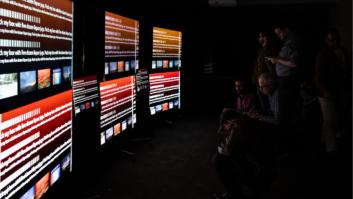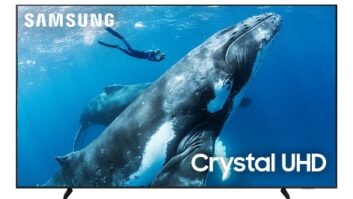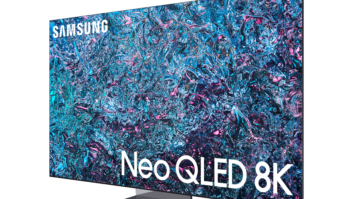With a $15 discount, Fire TV Stick moved a few units over Black Friday, but no where near as many as Chromecast.
Regardless of what your prognostication is for the long-term future of physical media as a program playback source, there is no question that streaming services and IP-delivered content are multiplying daily as a key method by which consumers, your prospects, clients, and customers access entertainment and informational content. At the same, the devices used to access those sources have multiplied, as well.
For many, there is simply no need for one of these devices, as “Smart TVs”, “Connected Blu-ray players,” and video game consoles fill the bill with on-board apps to enable streaming. If an installation uses a projector that isn’t so “smart” or you want the connection direct to an AVR or surround processor for audio connectivity there are the “hockey puck” products such as those from Roku, AppleTV, Amazon Fire TV, and many others that will, to a greater or lesser degree, provide access to what has become a baseline of services such as Netflix and Hulu Plus, along with varying combinations of music services (Pandora, Spotify, etc.), “internet radio”, various provider- and Network-based services such as HBO-Go, Watch ESPN, special interest content (e.g. religious, news, sports, cooking, You Tube/user generated and content locally stored content via DLNA connectivity.)
All of this is fine, but at the moment no one single device can provide every service. That either means that you either have to compromise and miss out on something or use a collection of devices and products, which can get somewhat expensive when you begin to add everything up. Beyond that, with smartphones and tablets increasingly becoming the go-to portals for content as well as the replacement for a point-and-shoot camera in many homes, additional features have become important for “streaming content catchers” to answer the following hypotheticals:

“How can I show photos on my phone or tablet on the large screen?”
“If the app I want is not on my streamer box, how can I get it from the phone or tablet to the main screen?”
“What do I when travelling and the device that usually does this for me is home and I want to use the HDMI input on a hotel TV for streaming or photo viewing?”
“I want to show my phone’s web browser on the big screen!”
“I just want a low-cost streamer box so that all the ‘non-smart’ TVs in the house can stream without spending a fortune!”
Seeing an opening in the market for something that is low-cost and reasonably able to answer most, but not all needs in this category, Google introduced Chromecast in July 2013. Often referred to as a “Streaming Dongle” because of its small “plug in the back of the set” form factor, it only requires an available HDMI input on the TV or AVR, 5VDC power via a USB micro port, and configuration to WiFi and then, within reason, you are ready to “‘cast”.

Others have followed, but Chromecast set the benchmark and has become a huge seller thanks to a $35 price, consumer brand name recognition and a growing app library.
Others have followed, but Chromecast set the benchmark and has become a huge seller thanks to a $35 price, consumer brand name recognition and a growing app library. Oh, with one caveat: Since the Chromecast has no remote control you use your iOS or Android device to drive it, selecting content and emulating traditional transport start/stop controls. Yes, once you start the program, the Chromecast’s “Discovery and Launch,” or “DIAL” technology takes over and makes it possible for the phone or tablet to leave the room and the program will still play; the content comes from the Chromecast reaching out to the cloud, not from the phone or tablet. Nice, but limiting.
Taking a different approach, the Roku Streaming Stick has appeared; it’s basically a re-packaging of the Roku, packaged a dongle form factor. It’s a bit more expensive, but it has a lot more apps and a nice remote.
Now, as we move into the “holiday season,” Amazon has joined the “Dongle Wars” with its Fire TV Stick, which, to some extent, splits the difference between Chromecast and Roku’s Stick in the under-$50 market. With the Amazon product highly promoted well below its $39 list price during seasonal sales, I picked one up so I could offer some observations and thoughts on where it fits into the picture.
The Fire TV Stick is about the same size as the Chromecast, lacking the round bulge and looking like a jet-black pack of chewing gun. It comes with the same type of short HDMI extender as the Chromecast; a valuable feature when dealing with the tight spacing on many TVs or AVRs. Of course, there is the USB cable for power that can connect to a powered USB jack on a TV or work with the supplied wall-wart type adapter (recommended for more stable performance.)
What really begins to separate the Fire TV Stick from the Chromecast is its optional Bluetooth remote, featuring the traditional play/pause/FF/RW “transport” controls and navigation buttons plus the Home, Back and Menu buttons required for a streaming product. That, alone, gives the Fire TV Stick one big plus that can be balanced against one of its two major competitors.
It should be noted that for intense game play it is advised that one purchase the Amazon Game Remote. Further, both Roku and Fire TV have very capable remote apps that drive the device quite well. Fire TV’s remote app even lets you use your phone or tablet’s mic to do voice search and app selection without springing for the dedicated remote from the Fire TV that includes that functionality. Chromecast’s app isn’t as much of a remote as the others, but given that it is designed from the get-go to use apps already on the hand-held and ‘cast them, a remote is somewhat of an afterthought.
Given that the Fire TV Stick packages the key technology of a Fire TV into a dongle, just as Roku does by squeezing its set-tops into a Stick, you have what is almost the obligatory package of 1080p video via HDMI and Dolby Digital Plus 7.1 audio (when available). There is a more powerful processor and more memory for storage and general operation than Chromecast, along with dual antennae/dual band a/b/g/n/ WiFi. The video and audio performance and quality is on par with the competition. Indeed, whether it is dramatically better or not may be determined more by the specifics of an individual installation than anything else. In my typical home system, one product was not measurably better than the others.

With streaming products it is in the apps and games where the rubber meets the road, and there the Fire TV Stick strikes a mid-point between the Chromecast and Roku Sticks.
With streaming products it is in the apps and games where the rubber meets the road, and there the Fire TV Stick strikes a mid-point between the Chromecast and Roku Sticks. For gamers it has the largest library. For apps it has, or will have within a few months, all the majors such as Netflix, Hulu+, YouTube, Pandora, Spotify, I Heart Radio, and Watch ESPN. HBO-GO is in the “coming soon” category, but for now it doesn’t have the extensive list of major supplier apps available with a Roku or Chromecast. However, again as with any of these products, it is a question which apps your clients want and use and if they are there. That is what makes it a deal or not.
As one might expect, just as Chromecast is going to have an edge in implementing apps and accessing content from Google, its parent company, Amazon’s Stick clearly favors Amazon’s audio and video services. They’re all there at start up, greatly simplifing access to that extensive library of content, particularly for someone who is an Amazon Prime subscriber. Other apps have to be downloaded and installed. That’s certainly not a major task, but it is something you’ll have to do when provisioning the Fire TV Stick for clients
When it comes to apps, all Roku products (the Streaming Stick included) have the apps resident in a “Channel Store”, and adding them to “My Channels” is a few simple remote clicks away. Yet to my way of looking at these products, the ultimate app for content access isn’t an app at all. Rather, it is the ability to use a smartphone or tablet to select any desired content, whether it is “cast-able” or not, use a browser or any app or view personal photo and movies stored on the hand-held product and simply mirror to the display via the Stick/dongle. With that capability “you don’t need no sinkin’ apps” and the dongle becomes a low-cost wireless portal to a display.
As might be expected, the Fire TV Stick, like its $99 “hockey puck” Fire TV big brother, is set out of the box to mirror from Amazon’s Fire tablet and phone products. Similarly, Chromecast now mirrors anything being viewed on select Android devices and it also has the capability to use Miracast to mirror from any Android device. Roku also has a beta product that lets you mirror Android devices to a connected big screen. Again, your success may vary with older versions of Android and less popular devices, but for the most part all three products were equal for mirroring Android-based products.
Here’s where I see a major breakthrough for the Fire TV Stick. Once I spent $4.99 to install an app called “AirPin(Pro),” I was able to mirror from an iPad and iPhone by simply selecting the Fire TV as an AirPlay device. Until now, iOs mirroring required a $99 AppleTV to easily mirror Apple devices and that is hardly a portable or very inexpensive device. With the Fire TV Stick, our total investment, including the app, is less than half the cost of an AppleTV.

Mirroring iOS devices is a big plus for the Fire TV Stick.
Where this difference may be key is when you or your clients use iOS (or Android) products for presentations, require a wireless connection to a projector, and want as lightweight and inexpensive a device as you can get. Yes, you can do that with a cable or an AppleTV (for iOS only, of course), but here you have small size, light weight, and low cost. That makes it easy to throw this together with an inexpensive WiFi “Travel Router.” That can be as expensive as an AirPort Express or as cheap as less than $20 for one of the new “nano-routers” available online. Pour in Office 365, Keynote, or similar and you are ready to put the show on the road for a very nominal cost.
Thinking further, in your role as “Digital Concierge” to your clients, pack this up in a nice case with a brief “Cheat Sheet” instruction guide on a laminated card and they are ready to go, as well. Even better, with an increasing number of hotel TV sets letting you connect an external HDMI device, it is a simple matter connecting the access point to the hotel’s broadband or tethering to a phone for 4G and they can check the presentation for the next morning on business travel or look at the day’s selfies or vacation pics when travelling with the family.
Even better, both Chromecast and the Fire TV Stick have said they will soon offer updates that let you use “guest WiFi” so that when in a hotel or visiting relatives you will be able to use any system so that you won’t need to “bring your own WiFi.” Given the browser-based authentication typically required for hotel broadband, it might be a bit more difficult to pull that trick off with a Streaming Stick, but the folks at Roku are masters at making the seemingly impossible, possible.
Which Device is the Best?
From all of this we’ll guess that you’re about ready to ask, “So what is the real difference and which is better?” Good question. Roku has the most apps by far and does Android mirroring. It comes with a remote or remote app that make navigation easy to use and the apps work in a somewhat common, easy-to-use manner. Chromecast has gained even more stature in recent months with the addition of Android mirroring to a wide range of Chromecast-specific apps. As long as you are comfortable with the “no remote” design that means a handheld must be used to control content, it is a very capable and proven product.
The new Fire TV Stick has the most games, but for now the fewest apps. The remote is a bonus over Chromecast if you have the apps required. For me, however, it is the albeit somewhat clumsy but still unique capability to mirror iOS with a low-cost dongle that merits the attention for mobile presenters as long as the display has HDMI in addition to VGA.
Now that you have a picture of the pros and cons of each product, it really boils down to which device works best for you or a particular client. Depending on whether the “dongle Stick” is for home or travel they might even be best served by two, or perhaps one of each. Indeed, with the likelihood that the low prices seen for all three over Black Friday/Cyber Monday we suggest that you purchase one of each for your own exploration and evaluation. In addition to taking advantage of holiday pricing to be able to get familiar with them, in the long term I plan to use mine as sources to fill up AVRs, TVs, and processors under test so that there is a cheap way to have an active source on all inputs. Try doing that for under $100 with cable boxes, video games, or optical players!
The recent introduction of Amazon’s Fire TV Stick has brought this class of device to my attention again, and it should do that as well for you. Take a look at how the services you can attach to them will bring value to what you offer your customer base outside of the actual hardware cost and we think you’ll be surprised at the possible opportunities. Beyond that, at the cost we’re seeing for them now, any one of these might make a great gift for clients when packaged in that nice case with a router. Why gift with a fruit basket that is eaten once when these will provide content that may be consumed all year—and they’ll think of you every time they do so!
Based in Sherman Oaks, CA, Michael Heiss is a contributing editor to Residential Systems.
“Dongles” Caption: Chromecast, Roku’s Streaming Stick (seen here in the earlier MHL version) and the new Amazon Fire TV Stick are all about the same length.
“BF” Caption: With a Black Friday price of $24, Chromecast sold out at our local Best Buy.
“Fire TV A and B” Caption: Not to be outdone by the competition, the New Amazon Fire TV Stick was under $24 at Staples the same week on-line orders were shipped.
CEDIA Fellow Michael Heiss is a contributing editor to Residential Systems out of Sherman Oaks, CA.








